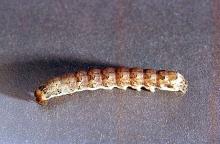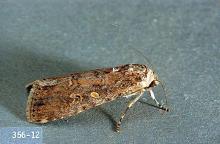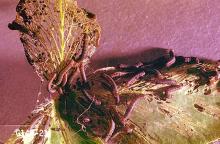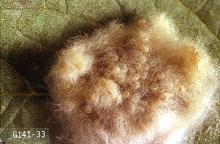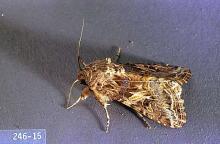Includes
Beet armyworm (Spodoptera exigua)
Bertha armyworm (Mamestra configurata)
Western yellowstriped armyworm (Spodoptera praefica)
Pest description, crop damage and life history
See:
Common Pests of Vegetable Crops
Pest monitoring The bertha armyworm is considered a "climbing cutworm" because it spends little time near the ground. It can be easy to miss while scouting, because though eggs and young instars tend to be clustered, later in the year they disperse actively. Larvae also tend to drop quickly from plants when disturbed, avoiding detection. Populations can explode due to an influx of overlapping generations of migrating moths along with overwintering populations.
Pheromone traps are useful for determining when major flights occur but not for predicting damage. A 5-minute search is useful in determining the need for treatment. On average, if one or more larvae or egg masses are found in 5 minutes, treatments may be justified. In those rare instances when control measures are required, the beet armyworm is more difficult to control than the western yellowstriped armyworm. Insecticide applications are most effective if applied against small larvae.
Management-biological control
Common natural enemies of armyworms include several braconid and ichneumonid wasps, many general predators including assassin bugs, damsel bugs, and spiders, and a nucleopolyhedrovirus, reported to have brought about excellent late year control in Canada. None of these natural enemies can be counted upon to achieve adequate control in any given year.
Management-cultural control
Weed control is important. Lambsquarters and wild mustard attract egg-laying females and provide a source of food for larvae. Fall tillage can help destroy overwintering pupae.
Management-chemical control: HOME USE
Apply any one of these materials to the soil surface at first sign of cutworm activity. Consult label. Minimum preharvest interval (PHI) varies with crop.
- acetamiprid
- azadirachtin (neem oil)-Some formulations are OMRI-listed for organic use.
- Bacillus thuringiensis var. kurstaki (Btk)-Some formulations are OMRI-listed for organic use.
- bifenthrin (often as a mix with zeta-cypermethrin)
- capsaicin-Some formulations are OMRI-listed for organic use.
- carbaryl
- cyfluthrin
- esfenvalerate-Do not use on Brussels sprout.
- gamma-cyhalothrin
- horticultural oil-Some formulations are OMRI-listed for organic use.
- insecticidal soap-Some formulations are OMRI-listed for organic use.
- kaolin-Applied as a spray to foliage, it acts as a repellent to some insect pests. Some formulations are OMRI-listed for organic use. Not registered for use in OR
- lambda-cyhalothrin
- permethrin
- plant essential oils (rosemary, etc.)-Some have demonstrated efficacy against lepidopteran larvae. Some formulations are OMRI-listed for organic use.
- pyrethrins (often combined with other ingredients)-Some formulations are OMRI-listed for organic use.
- spinosad-Some formulations are OMRI-listed for organic use.
- zeta-cypermethrin
Management-chemical control: COMMERCIAL USE
- alpha-cypermethrin (Fastac EC) at 0.02 to 0.025 lb ai/A. PHI 1 day. REI 12 hr. Retreatment interval 7 days. Do not exceed 0.075 lb ai/A per season.
- azadirachtin (Neemix 4.5) at 0.14 to 0.35 lb ai/A. PHI 0 days. REI 4 hr. OMRI-listed for organic use. Not listed for use in OR.
- Bacillus thuringiensis (Javelin) 0.12 to 1.5 lb/A. PHI 0 days. REI 4 hr. Slow acting. May need multiple applications. Add an appropriate spreader-sticker to enhance control. Most effective on small larvae. Some formulations are OMRI-listed for organic use.
- beta-cyfluthrin (Baythroid XL) at 0.019 to 0.025 lb ai/A. PHI 0 days. REI 12 hr. Retreatment interval 7 days. Do not exceed 0.1 lb ai/A per season.
- beta-cyfluthrin/imidacloprid (Leverage 360) at 0.07 lb ai/A. PHI 7 days. REI 12 hr. Retreatment interval 7 days. Do not exceed 0.1 lb ai/A beta-cyfluthrin or 0.2 lb ai/A imidacloprid per season.
- bifenthrin (Brigade WSB, Sniper) at 0.033 to 0.1 lb ai/A. PHI 7 days. REI 12 hr. Do not exceed 0.5 lb ai/A per year. Do not make more than five applications after bloom. Retreatment interval 7 days.
- bifenthrin (Capture LFR) at 0.04 to 0.08 lb ai/A at planting in furrow or broadcast to soil surface. Do not exceed 0.1 lb ai/A per season at plant application. Refer to label instructions.
- bifenthrin/imidacloprid (Brigadier) at 0.06 to 0.095 lb ai/A. PHI 7 days. REI 12 hr. Do not exceed 0.24 lb ai/A imidacloprid and 0.24 lb ai/A bifenthrin as a foliar application. Retreatment interval 7 days. Maximum 5 treatments only after bloom.
- bifenthrin/zeta-cypermethrin (Hero EW) at 0.04 to 0.1 lb ai/A. PHI 7 days. REI 12 hr. Retreatment interval 7 days. Do not exceed 0.45 lb/A per season. Limit 5 applications after bloom.
- Burkholderia spp. (Venerate XC) at 1 to 4 quarts/A product. PHI 0 days. REI 4 hr. OMRI-listed for organic use.
- carbaryl (Sevin 5 Bait) at 1 to 2 lb ai/A foliar or 2 lb ai/A as bait. PHI 3 days. REI 12 hr. Retreatment interval 7 days. Do not exceed 6 lb ai/A per crop. Limit 3 bait treatments per year.
- chlorantraniliprole (Coragen) at 0.045 to 0.098 lb ai/A at planting; via drip irrigation; as foliar. PHI 3 days. REI 4 hr. Retreatment interval 3 days for foliar and 10 days for drip. Do not exceed 0.2 lb ai/A per season. Consult label for details.
- chlorantraniliprole/thiamethoxam (Voliam Flexi) at 0.1 to 0.175 lb ai/A. PHI 3 days. REI 12 hr. Retreatment interval 7 days. Do not exceed 0.172 lb ai of thiamethoxam or 0.2 lb ai of chlorantraniliprole per acre per growing season.
- Chromobacterium subtsugae (Grandevo) at 0.3 to 0.9 lb ai/A per 100 gal. PHI 0 days. REI 4 hr. OMRI-listed for organic use.
- cryolite (Kryocide) at 7.7 to 15.4 lb ai/A. PHI 7 days for broccoli, cauliflower, and Brussels sprout, and 14 days for cabbage. REI 12 hr. Do not exceed 92 lb ai/A per season. OMRI-listed for organic use. Only registered for use in WA.
- cyantraniliprole (Exirel) at 0.045 to 0.088 lb ai/A. PHI 1 day. REI 12 hr. Retreatment interval 5 days. Limit 6 treatments per year. Do not exceed 0.4 lb ai/A per year.
- cyclaniliprole (Harvanta 50SL) at 0.036 to 0.054 lb ai/A. REI 4 hr. PHI 1 day. Retreatment interval 7 days. Limit 3 treatments per crop. Do not exceed 0.22 lb ai/A per year. Some restrictions on application timing. Not registered for use in WA.
- cyfluthrin (Tombstone) at 0.038 to 0.05 lb ai/A. PHI 0 days. REI 12 hr. Retreatment interval 7 days. Do not exceed 0.2 lb/A per season.
- emamectin benzoate (Proclaim) at 0.0075 to 0.015 lb ai/A. PHI 7 days. REI 12 hr. Retreatment interval 7 days. Do not exceed 0.06 lb ai/A (28.8 oz/A) per season. Do not allow livestock to graze in treated areas.
- esfenvalerate (Asana XL) at 0.03 to 0.05 lb ai/A. PHI 3 days. REI 12 hr. Do not use on Brussels sprout. Do not exceed 0.4 lb ai/A per year.
- fenpropathrin (Danitol 2.4EC) at 0.2 to 0.3 lb ai/A. REI 24 hr. PHI 7 days. Do not exceed 0.8 lb ai/A per season.
- flubendiamide/buprofezin (Vetica) at 0.21 to 0.42 lb ai/A. PHI 1 day. REI 12 hr. Minimum application interval 7 days. Limit 2 treatments. Do not exceed 0.83 lb ai/A per year. Product Not registered for use in OR.
- gamma-cyhalothrin (Declare) at 0.01 to 0.015 lb ai/A. PHI 1 day. REI 24 hr. Do not exceed 0.12 lb ai/A per season. Effective on first and second instar. Toxic to bees.
- GS-omega/kappa-Hxtx-Hv1a (Spear Lep) at 0.02 to 0.04 lb ai/A. PHI 0 days. REI 4 hr. Do not exceed 1.7 lb ai/A per year.
- indoxacarb (Avaunt) at 0.065 lb ai/A. PHI 3 days. REI 12 hr. Use of wetting agent recommended. Retreatment interval 3 days. Do not exceed 0.26 lb ai/A per year.
- lambda-cyhalothrin (Warrior II) at 0.02 to 0.03 lb ai/A. PHI 1 day. REI 24 hr. Retreatment interval 5 days. Do not exceed 0.24 lb ai/A per year.
- lambda-cyhalothrin/thiamethoxam (Endigo ZC) at 0.064 to 0.072 lb ai/A. PHI 1 day. REI 24 hr. Retreatment interval 7 days. Do not exceed 0.24 lb ai of lambda-cyhalothrin or 0.172 lb ai/A of thiamethoxam per season.
- methoxyfenozide (Intrepid 2F) at 0.06 to 0.12 lb ai/A for early-season application; at 0.12 to 0.16 lb ai/A for mid- to late-season application or heavy infestation. PHI 1 day. REI 4 hr. Adding adjuvant improves performance. Do not exceed 1.0 lb ai/A per season.
- novaluron (Rimon 0.83EC) at 0.039 to 0.078 lb ai/A. PHI 7 days. REI 12 hr. Retreatment interval 7 days. Do not exceed 0.16 lb ai/A per season.
- permethrin (ermethrin Cutworm bait) at 0.05 to 0.1 lb ai/A (cauliflower and Brussels sprout) and 0.01 to 0.2 lb ai/A (broccoli and cabbage). PHI 1 day. REI 12 hr. Do not exceed 0.8 lb ai/A on broccoli, and 0.4 lb ai/A on cauliflower, Brussels sprout and cabbage per season.
- permethrin (Permethrin) at 0.05 to 0.2 lb ai/A broccoli, cauliflower & Brussels sprout or 0.1 to 0.2 lb ai/A for cabbage. PHI 1 day. REI 12 hr. Retreatment interval 5 days. Do not exceed 0.8 lb ai/A on broccoli or 0.4 lb ai/A on Brussels sprouts, cabbage and cauliflower per season.
- spinetoram (Radiant SC) at 0.039 to 0.078 lb ai/A. PHI 1 day. REI 4 hr. Retreatment interval 4 days. Do not exceed six applications or 0.266 lb ai/A per season. Do not apply to seedling cole crops grown for transplant within a greenhouse, shade house, or field plot.
- spinosad (Success, Entrust SC) at 0.06 to 0.156 lb ai/A. PHI 1 day. REI 4 hr. Treat eggs at hatch and small larvae. Do not exceed three times in a 30-day period. Do not exceed 0.45 lb ai/A or six applications per crop. Entrust SC is OMRI-listed for organic use.
- tebufenozide (Confirm 2F) at 0.09 to 0.12 lb ai/A early year; 0.12 lb ai/A mid to late year. PHI 7 days. REI 4 hr. Do not exceed 1.8 lb ai/A or 15 applications per year. Retreatment interval 10 to 14 days. Use of a surfactant is recommended.
- thiamethoxam/chlorantraniliprole (Durivo) at 0.195 to 0.257 lb ai/A applied to the soil. PHI 30 days. REI 12 hr. Do not exceed 0.172 lb ai of thiamethoxam or 0.2 lb ai of chlorantraniliprole per acre per growing season.
- tolfenpyrad (Torac) at 0.21 lb ai/A. PHI 1 day. REI 12 hr. Retreatment interval 14 days. Limit 4 treatments. Do not exceed 0.42 lb/A per year. Ground application only.
- zeta-cypermethrin (Mustang Maxx) at 0.04 to 0.05 lb ai/A. PHI 1 day. REI 12 hr. Do not exceed 0.3 lb ai/A per year. Retreatment interval 7 days.

